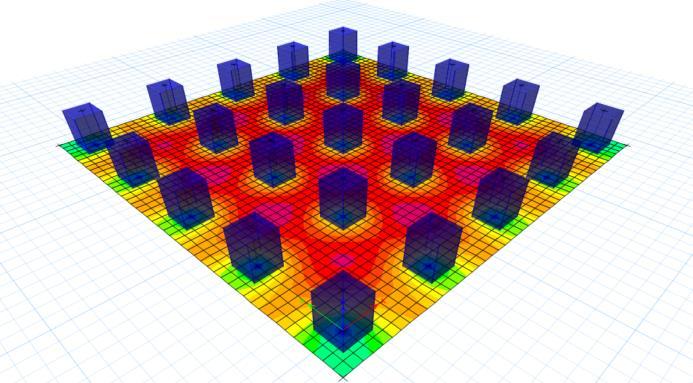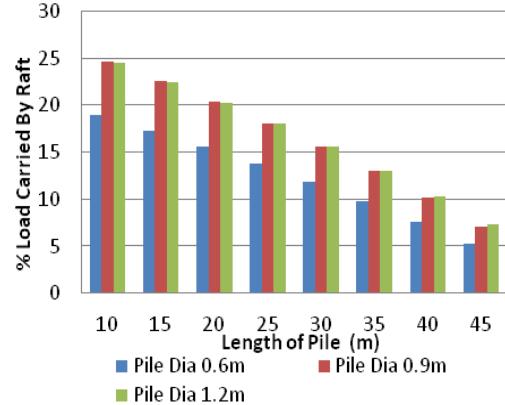

A Review on Comparative Analysis of Raft Foundation, Raft with Drop & Pile Raft Foundation
Shaktisinh Raol1 , Aakash Suthar2 ,
1M Tech Student, L.J. University, Ahmedabad
2Aakash Suthar, Professor, Structural Engineering Department, L.J. University, Ahmedabad, India.
Abstract - The study conducts a comprehensivecomparative analysis ofthree distinct foundationsystems:RaftFoundation, Raft with Drop, andPileRaftFoundation.Employingadvanced structural analysis and design software, the research aims to gain insights into the structural and geotechnical behavior of these foundation systems. Various loading scenarios and soil profiles are considered to assess their performance comprehensively. The analysis involves crucialfactorssuchas loaddistribution, stress concentrations,andoverallstructural performance, utilizing the finite element analysis capabilities of CSI SAFE software. This sophisticated software is instrumental in modeling bearing capacity, settlement features, andthe interactionbetweenthe foundationandsoil, providing a holistic understanding of the geotechnical elements involved
Key Words: Foundation Design, Raft Foundation, Pile Raft foundation, Raft with Drop, Structural Design, Seismic Load, CSI SAFE, Etabs.
1. INTRODUCTION
The choice of a suitable foundation system for high-rise buildingsisacrucialfactorindeterminingtheirstabilityand resilienceinthedynamicfieldofstructuralengineering.A deeper comprehension of foundation design is more and more important as urban landscapes, marked by an increasing demand for vertical development, continue to change.UsingETABSandCSISAFESoftware,thisstudyaims to conduct a thorough investigation into the Comparative Analysis of Raft Foundation, Raft with Drop, and Pile Raft Foundation.Themainobjectiveistocarefullyexamineand makerelevantcomparisons betweenthese three different foundation systems' geotechnical response and structural performance in the context of high-rise buildings. By utilizing cutting-edge engineering software, ETABS for structural analysis and design and CSI SAFE for thorough foundationmodelling,thisresearchaimstoinvestigatethe complexinteractionsbetweenthesefoundationsunderthe combinedeffectsofdifferentseismiczonesanddifferentsoil types.
Themainfocusisondecipheringtheintricatedynamicsof howvariousfoundationtypesrespondtoseismicforcesand accommodate the various soil profiles typical of various geographiclocations.Itisanticipatedthattheresultsofthis
comparative analysis will offer practitioners and stakeholderspricelessinsights,enablingeducateddecisionmakingintheselectionoffoundationsystemscateredtothe particular difficulties presented by various seismic zones andsoiltypes.Theultimategoalofthisresearchistomakea valuable contribution to the continuous improvement of foundationdesigntechniques,whichwillprotecthigh-rise buildings'structuralintegrityandlong-termresilienceina varietyofdynamicurbanenvironments
TheuseofETABSforstructuralanalysisanddesignsuggests acommitmenttoutilizingcutting-edgecomputationalpower to examine and enhance the structural componentsoftall structures.Thisentailsevaluatinghowthestructurereacts to different loads, making sure it complies with safety regulations, and maximizing its overall effectiveness. Indepthfoundationmodellingisdoneconcurrentlywiththe useofCSISAFEsoftware,highlightingthecrucialpartthat foundationsplayinthestructuralintegrityoftallbuildings.
Essentially,thisstudyaddstothecurrentdiscussiononhighrisebuildingfoundationsystemsanddemonstratestheuse of cutting-edge engineering instruments to carry out an exhaustive analysis. It is anticipated that the results will influenceanddirectstructuralengineeringdecisionsinthe future,assistinginthecreationofhigh-risebuildingsthatare safer and more resilient in the face of changing urban environmentsandseismichazards.


1.2 Objective
To compare the Raft Foundation, Raft with Drop, and Pile Raft Foundation utilizing structural analysisanddesignsoftware.
To support ongoing advancements in high-rise building foundation design methodologies, guaranteeing long-term resilience and structural integrityindynamicurbansettings.
To shed light on the relative merits and costs of various foundation designs, especially in regions withpoorsoilandbig,heavystructures.
To provide thorough understanding of different types of foundations, their advantages and disadvantages, suitable situations, and design construction.
To research and evaluate the various kinds of foundationsutilizedinthebuildingsector,aswell astheirdesignsandtheapplicationofalternative materialstoimprovetheirfirmness,toughness,and environmentalfriendliness.
To construct strong, affordable, and ecologically friendly foundation bases for bungalows and tall buildingsalike.
To examine elements like soil bearing capacity, settling, and seismic behaviour in relation to raft, pile,andpiledraftfoundations
2. Literature Review
[1] Magar, J., Kudtarkar, A., Pachpohe, J., & Nagargoje, P. (2020). Study and analysis of types of foundation and design construction. IRJET, 7, 3301-3307.
Thetypesoffoundationsusedintheconstructionindustry, theirdesigns,andtheuseofsubstitutematerialstoimprove theirfirmness,durability,andenvironmentalfriendlinessare allcoveredinthispaper.Ithighlightshowcrucialitistobuild asolidfoundationthatwillnotcollapseordeteriorateunder anyweather.Forhigh-risebuildingsandbungalows,different foundationtypesareutilized;eachhasaspecialconfiguration anddesigntoimprovestabilityanddurability.Thegoalofthe studyistocreateafoundationbasethatisresilienttonatural disasters,economical,andenvironmentallyfriendly.
Thestudycomestotheconclusionthatvariousfootingand foundationtypes have particularapplications in particular regions and climates. It highlights how crucial it is to comprehend foundation work when performing construction-related tasks. The study emphasizes the necessity of building a solidfoundation that is resistantto collapseanddecayunderall-weathercircumstances.Ittalks aboutthedifferentkindsoffoundationsusedinthebuilding sector,howtheyaredesigned,andhowtousenon-traditional materials to make them more sturdy, long-lasting, and environmentallyfriendly.Inordertoreducethechanceofa structurecollapsing,thepaperalsostresseshowcrucialitis
tousetherightmaterialsforthefoundation.Itoffersdetails on the kinds of superstructures that require what kind of foundation,aswellasappropriatematerialsanddesigns.The study'soverallgoalistooffercomprehensiveandcollective knowledgeregardingthevariouskindsoffoundations,their benefits and drawbacks, appropriate circumstances, and designconstruction.
[2] Srivastava, R. K. Structural Design of Raft Foundation
For 30 story high rise building-A case study in Lucknow, Uttar Pradesh region, India
The30-storyhigh-risebuilding'sraftfoundation'sstructural layout in Lucknow, Uttar Pradesh, India. The writers talk aboutthevalueofcleverandaffordablefoundationsystems fortallbuildingsinlightofthelimitedavailabilityoflandin desirable areas, particularly in India's major cities. They stress the importance of the local soil and suggest a raft foundationonalluvialsoilasausefulfix.Tomakesurethe stresses are within the permitted bounds, the design considerationsincludeexaminingthemaximumaxialload, soil pressure, and moments on the raft foundation. The applicationofgeotechnicalanalysisanddesignprinciplesfor raftfoundationsinalluvialregionsisalsohighlightedinthe paper

Safety requirements were given when designing the Raft foundationinaccordancewithIndianStandards,takinginto account the alluvial type of soil. This paper studies and applies the raft foundation design in relation to different geotechnical aspects that must be integrated into the final design.Theentireraftisnaturallysaggingduetothebending momentcausedbyloosesoil.Butatensionzoneformsassoil stiffness rises. The tension zone's extent and intensity increaseaswemovefromtheedgetowardthecenter.Butthe effectisstrongerintheXdirectionthantheYdirection.The pressuredistributionbeneaththeraftincreasestowardsthe centerofloosesoil,withthedistributionbeingloweratthe edge. It stays nearly constant in the central zone between

columns.Thepressuredistributioninmediumsoilishighest attheperipheryanddecreasesverygraduallytowardsthe center. Pressure distribution in hard soil is high at the margins,decreasesbeneaththeedgecolumns,andthenrises inthecenter.Thereislessthan50millimetersofsettlement andpunchingshearfactorsarelessthan1.
[3] Krishna, A. M., Teja, A. P.,Bhattacharya,S.,&Ghosh,B. Seismic Design of Pile Foundations for Different Ground Conditions. In 15 World Conferences on Earthquake Engineering, Lisboa 2012
The importance of taking ground conditions into account during the design process is emphasized in this paper's discussion of the seismic design of pile foundations for variousgroundconditions.Inadditiontodiscussingdesign considerationsbasedonvarioustheoriesonpilefoundation performance under seismic conditions, it presents the estimationofseismicloadsforamulti-storybuildinglocated in different seismic zones. The seismic design of pile foundations in accordance with Indian and European standards is demonstrated using two different ground conditionsasexamples

Fordifferentstructurestofunctioneffectivelyunderextreme seismicloadingconditions,pilefoundationseismicdesignis essential. The capacity of the foundation and the seismic loadstransferredtoitarelargelydependentontheground conditions,particularlythetypeofsoil.Theseismicdesignof pilefoundationsforvariousgroundconditionsispresented in the paper, taking European and Indian standards into consideration. It covers the estimation of seismic loads, theory-baseddesignconsiderations,andoffersexamplesof seismicdesignforvariousgroundsituations.Theimpactof liquefactiononpiledesignisalsohighlightedinthepaper.It recommendsignoringthefrictionalresistanceprovidedby theliquefiablelayer'ssoil, buildingthe pile as a columnto preventbuckling,andtakingliquefaction-relatedchangesto thesystem'sfixitypointandnaturalperiodintoaccount.The findingsindicatethatinordertoachieveafactorofsafetyof 3.5 for a liquefiable soil layer, a driven cast in-situ, free-
headedpilewithalengthof18mandadiameterof0.95mis advised
[4] Azhar, S., Patidar, A., & Jaurker, S. (2020). Parametric Study of Piled Raft Foundation for High Rise Buildings. International Journal of Engineering Research & Technology, 9(12), 548-555.
By varying variables like raft thickness, pile diameter, pile length,andpilespacing,thestudyexaminesthebehaviorand performanceofcombinedpiledraftfoundations.Byaltering theseparameters,itseekstocomprehendchangesinpile/raft load sharing ratios, differential settlement, maximum moment in the raft, and settlement. In order to prepare foundationmodelswithvariousgeometricalconfigurationsin SAFEsoftware,ETABSsoftwareisusedtomodelandanalyze a twenty-story building. The piled raft foundation's appropriate configuration and design are determined by a numberofparameters,withtheaidoftheparametricstudy.

Maximum pressure, settlement and differential settlement reduces only up to a limit with increasing raft thickness. Followingthat,therearenoreal benefitstothickeningthe raft.Instead,there isanincreasein maximal moment. The needforsteelmayrisealongwiththethicknessoftheraft, creatingpartsthatarenotcost-effective.Acleardecreasein the load supported by the raft occurs as the pile diameter increases.Greaterdiameterofthepileslowersdifferential, maximum pressure, and settling. As the pile diameter is increasedpastacertainpoint,thereisvirtuallylittledecrease inthesevalues.Therefore,theexpenseofalargerdiameter will be more than the benefits. There is an increase in maximumpressure,differentialsettling,andsettlementwith increasing pile spacing. Forevery pile diameter taken into consideration,theresultingcurvesarequitesimilar.Inorder tocutcosts,asmallerdiametermustbechosen.Aspilelength increases,settlementsandthemaximumpressurebeneath the raft diminish. Although the weight borne by the pile groupincreasesaspilelengthgrows,thisincreaseisnotas

importantastheadditionalcostsassociatedwithlongerpiles.
Althoughpiledraftfoundationsareasuperiorwaytomanage settlements,forthesefoundationsystemstoperformattheir best, the most cost-effective and ideal geometrical arrangementmustbeused.
[5] Dhage, A., & Solanke, S. S. (2023, June). Comparative Analysis of Raft, Pile & Piled Raft Foundation using Designing Software. In IOP Conference Series: Earth and Environmental Science (Vol. 1193, No. 1, p. 012006). IOP Publishing)
Thepapercomparestheperformanceofraft,pile,andpiled raftfoundationsusingstructuralsoftware,specificallyfora G+20residentialstructure.Itanalyzesfactorssuchasseismic behavior, soil carrying load, and settling to determine the effectiveness of each foundation type. The study aims to provideinsightsintotheeffectivenessandcost-effectiveness ofdifferentfoundationtypes,particularlyinareaswithweak soilandlarge,heavystructures.

Thepiledraftfoundationwasfoundtohavelessupward soil carrying load and settling compared to the raft foundation,makingitamoresuitableoptionforareaswith weak soil and large, heavy structures. The pile foundation wasfoundtofailinpunchingshear,whiletheraftfoundation failed in settlement conditions, exceeding the permissible limits.Thesettlementofthepiledraftfoundationwasfound tobebelowthepermissiblelimits,indicatingitsstability.The soilupwardpressurewasreducedinfoundationswithpiles, with the raft primarily governing the settlement of the structureinthesoil.Thepiledraftfoundationdemonstrated lowersoilpressureandpunchingshearvaluescomparedto thepilefoundation,makingitasaferoption
3. CONCLUSIONS
Through the use of software such as ETABS and CSI SAFE based research above, the study on different types of foundationssuchasraftfoundation,pilefoundation,pileraft foundation,andraftfoundationwithdropperformanceon different types of soil type and different types of Indian seismiczone,itisconcludedthat,
Thestudy'sconclusion,whichhighlightstheneedof comprehendingfoundationworkinbuilding,states
that different footing and foundation types have uniqueapplicationsindistinctplacesandclimates. It emphasizes how important it is to construct a sturdy foundation that will not collapse or deteriorateinanytypeofweather,anditprovides informationondifferentfoundationtypes,designs, and the use of unconventional materials. The importance of choosing the proper materials for foundationsisemphasizedinthearticle,whichalso offers information on superstructures, suitable materials, and designs to lower the danger of structuralcollapse
The section on the Raft foundation in respect to Indian Standards emphasizes the need for safety and covers the design's geotechnical elements. It examinesthetensionzonethatdevelopswhensoil stiffness rises as well as the raft's overall sagging causedbyloosesoil.Factorsrelatedtosettlement and punching shear are described, as well as changes in pressure distribution in various soil types
The seismic design of pile foundations under extremeseismicloadingcircumstancesiscoveredin the next section. It highlights how foundation capacityandseismicloadsaredependentonground conditions, especially soil kinds. The impact of liquefaction on pile design is one of the several groundconditionsthatarecoveredinthearticleon earthquakedesign.Itofferspreciseinstructionsfor obtainingafactorofsafetyinliquefiablesoillayers and suggests countermeasures to liquefaction effects
The performance of raft, stacked and piled raft foundations is compared in the final section. It implies that stacked raft foundations offer higher stability,lowersoilpressure,andreducedpunching shear values compared to pile foundations. Large constructionsandpoorsoilarethoughttobemore suitedforthestackedraftfoundation,whichhasa smaller settlement and soil-carrying load and is henceasaferandmorecost-effectivechoice.
In summary, the study provides comprehensive insights into different foundation types, their applications, design considerations, and safety measures. The comparison of raft, pile, and piled raft foundations suggests that the latter is a preferableoptionintermsofstability,soilpressure, andpunchingshearvalues
REFERENCES
[1] Magar, J., Kudtarkar, A., Pachpohe, J., & Nagargoje, P. (2020).Study andanalysis oftypesoffoundationand designconstruction.IRJET,7,3301-3307.

[2] Srivastava, R. K. Structural Design of Raft Foundation For30storyhighrisebuilding-AcasestudyinLucknow, UttarPradeshregion,India.
[3] Krishna,A.M.,Teja,A.P.,Bhattacharya,S.,&Ghosh,B. SeismicDesignofPileFoundationsforDifferentGround Conditions. In 15 World Conferences on Earthquake Engineering,Lisboa2012.
[4] Azhar, S., Patidar, A., & Jaurker, S. (2020). Parametric StudyofPiledRaftFoundationforHighRiseBuildings International Journal of Engineering Research & Technology,9(12),548-555.
[5] Dhage, A., & Solanke, S. S. (2023, June). Comparative Analysis of Raft, Pile & Piled Raft Foundation using DesigningSoftware.InIOPConferenceSeries:Earthand EnvironmentalScience(Vol.1193,No.1,p.012006).IOP Publishing.
[6] Shakir,S.,Mudassir,S.,&Abdullah,S.(2020).Analysisof Raft&PileRaftFoundationusingSafeSoftware.
[7] ReinforcedConcrete Vol.II.India,CharotarPublishing HousePvt.Limited,2008.
[8] IS 1904 (1986): Code of practice for design and construction of foundations in soils: General requirements [CED 43: Soil and Foundation Engineering]
[9] IS 2911-1-4 (2010): Code of practice for design and constructionofpilefoundations,Part1:Concretepiles, Section4:Boredprecastconcretepiles[CED43:Soiland FoundationEngineering]
